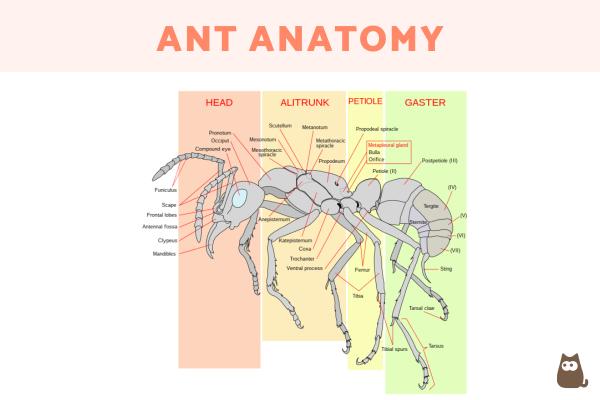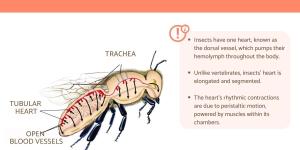Do Ants Have a Heart to Pump Blood?


Although ants do have hearts, they do not pump blood around their body. This is because ants do not have blood. They have a fluid known as hemolymph which carries out a similar function. There are around 14,000 known species of ants, although there are likely many more to be discovered. They have a global distribution and live in a great diversity of habitats. Despite such diversity in species, they all conform to certain similar physical characteristics in their anatomy. They all have a body segmented into three parts, these being the head, thorax and abdomen. They have three legs, antennae and jaws. These body parts work thanks to certain internal organs, including a heart.
AnimalWised learns more by asking do ants have a heart to pump blood? We look at ant heart anatomy to learn how ants live and function so efficiently.
Do ants have hearts?
As with all insects, each different type of ant has an open circulatory system. This is a system where their body fluid is distributed directly to the various organs and which occupies most of the internal cavities. This body fluid is not blood, but a fluid known a hemolymph. Despite not being blood as is the case in vertebrate animals, hemolymph is analogous to blood since it carries out similar functions.
The only closed organ that ants and other insects have is known as the dorsal vessel. This dorsal vessel is the equivalent of a heart in ants, despite being structurally very different to our own. It is divided into two main parts, the heart and the aorta. The first has the same function as in vertebrate animals, except instead of pumping blood, it pumps hemolymph. The aorta has a conductive function. In its entirety, the dorsal vessel has an extension that goes from the back of the body, passes through the thorax and reaches the head.
As we have already ascertained, ants do have a heart, although not one like our own. It has the vital function of pumping hemolymph through the animal's body. This occurs from the posterior end, passing through the entire body along the dorsal vessel. In doing so, it passes through a series of chambers that have regulatory valves known as ostia. There are also accessory pumps that carry the fluid to the wings, although this is only in male and queen ants.
Hemolymph is essential in the body of ants. Although it does not transport oxygen, it does carry nutrients and hormones throughout the body. These hormones control its behaviors and physical actions. The hemolymph also transports waste to be excreted and contains cells specialized in protecting the body against foreign agents.
Furthermore, hemolymph differs from blood because it does not contain erythrocytes or red blood cells. In animals with blood, red blood cells contain the hemoglobin that transports oxygen. It also has a large amount of free amino acids.
You can learn more about how ants survive with our article on how long do ants live?
Anatomy of an ant heart
Although ants have a heart to pump hemolymph, it is not like the heart of other animals. The dorsal vessel has an elongated shape. This is a long, thin tube which allows it to run through almost the entire body of the animal, while transporting the circulatory fluid or hemolymph. In turn, there is a nerve cord that passes through the heart, and its function is to regulate how the circulatory system operates.
We can say there are three main parts of an ant heart anatomy, i.e. the anatomy of the dorsal vessel:
- Aorta: the aorta is the main tube or vessel that extends along the ant's back (dorsal side). It receives hemolymph from the posterior portion of the ant's body and pumps it anteriorly.
- Ostia: ostia are small openings or pores located along the dorsal vessel. They function like valves, allowing hemolymph to enter the aorta during the heart's relaxation phase and preventing backward flow.
- Heart: the ant's heart is essentially the aorta itself. It contracts rhythmically, pushing hemolymph forward through the ant's body.
For its part, the specific part of dorsal vessel that corresponds to the heart of ants has more of a spherical shape and is made up of tiny muscles. They help in the contraction and dilation of this organ. When this continuous process occurs, then the hemolymph is mobilized throughout the body. In this way, its function is similar in the rest of the animals that have a heart.
A study revealed that the pulse of ants is on average 53.5 beats per minute, and that it does not vary between different species that were studied[1]. This demonstrates the differences between the circulatory system of ants and that of animals with a closed circulatory system. Although the heart acts in a similar way, its shape is different. Being open, it carries hemolymph directly to other parts of the body, filling them with it.
Now we know about the organ which is the equivalent to an ant's heart, we might want to know the answer to the question do ants have brains like us?

Where is the heart of ants?
In general, the body of ants is divided into head, thorax (mesosoma) and abdomen (metasoma). In the latter, various vital systems for the animal are located, such as the respiratory, digestive, excretory, reproductive and part of the circulatory system. Although the dorsal vessel runs along the body, the part that corresponds to the heart or pumping system is located towards the abdomen, while the aorta area is located towards the head.
As we have seen, the circulatory system of ants has some analogies with other animals, but also differs substantially. These differences manifest in terms of shape, location, type and substance transported in the animal. However, as in any other animal, the heart of ants is essential for their life.
If you like ants, you may want to know more about them. You can do just that with our article on fun and interesting facts about ants.
If you want to read similar articles to Do Ants Have a Heart to Pump Blood?, we recommend you visit our Facts about the animal kingdom category.
1. Davis, A, Mei Clancy, K, & Sasaki, T. (2021). How to take an ant's pulse: a procedure for non-destructively monitoring baseline and stimulated heart rate in Formicidae. Retrieved from: https://sasakilab.ecology.uga.edu/wp-content/uploads/2021/08/eea.13071.pdf
- Brittanica. (2022). Insects. Retrieved from: https://www.britannica.com/animal/insect/Circulatory-system
- Kanost, M. (2009). Hemolymph. Editor(s): Vincent H. Resh, Ring T. Cardé, Encyclopedia of Insects (Second Edition).
https://doi.org/10.1016/B978-0-12-374144-8.00126-0 - Nature Blog Network (2023). Do Ants Have Hearts? Retrieved from: https://www.hummingbirdsplus.org/nature-blog-network/do-ants-have-hearts-explained-wildlife-informer/






